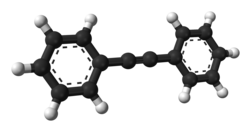Diphenylacetylene: Difference between revisions
Appearance
Content deleted Content added
m correct minus sign in superscript |
corrected boiling point from "0 - 60" to "170 C"; added other name "diphenylacetate" |
||
| Line 11: | Line 11: | ||
| ImageSize2 = |
| ImageSize2 = |
||
| IUPACName = 2-phenylethynylbenzene<!-- according to PubChem --> |
| IUPACName = 2-phenylethynylbenzene<!-- according to PubChem --> |
||
| OtherNames = Tolan<br />Diphenylacetylene<br />1,2-diphenylethyne |
| OtherNames = Tolan<br />Diphenylacetylene<br />1,2-diphenylethyne<br />diphenylacetate |
||
|Section1={{Chembox Identifiers |
|Section1={{Chembox Identifiers |
||
| ChEBI_Ref = {{ebicite|correct|EBI}} |
| ChEBI_Ref = {{ebicite|correct|EBI}} |
||
| Line 38: | Line 38: | ||
| MeltingPtC = 62.5 |
| MeltingPtC = 62.5 |
||
| Melting_notes = |
| Melting_notes = |
||
| BoilingPtC = |
| BoilingPtC = 170 C |
||
| Boiling_notes = at 0.3 mmHg |
| Boiling_notes = at 0.3 mmHg |
||
}} |
}} |
||
Revision as of 04:18, 26 March 2015

| |

| |

| |
| Names | |
|---|---|
| IUPAC name
2-phenylethynylbenzene
| |
| Other names
Tolan
Diphenylacetylene 1,2-diphenylethyne diphenylacetate | |
| Identifiers | |
3D model (JSmol)
|
|
| ChEBI | |
| ChEMBL | |
| ChemSpider | |
| ECHA InfoCard | 100.007.206 |
PubChem CID
|
|
CompTox Dashboard (EPA)
|
|
| |
| |
| Properties | |
| C14H10 | |
| Molar mass | 178.24 g/mol |
| Appearance | colorless solid |
| Density | 0.990 g cm−3, solid |
| Melting point | 62.5 °C (144.5 °F; 335.6 K) |
| Boiling point | [convert: invalid number] |
| insoluble | |
| Structure | |
| sp2 and sp at carbon | |
| 0 D | |
| Related compounds | |
Except where otherwise noted, data are given for materials in their standard state (at 25 °C [77 °F], 100 kPa).
| |
Diphenylacetylene is the chemical compound C6H5C≡CC6H5. The molecule consists of phenyl groups attached to both ends of an alkyne. It is a colorless crystalline material that is widely used as a building block in organic and as a ligand in organometallic chemistry.
Preparation
Several preparations for this compound exist:
- benzil is condensed with hydrazine to give the bis(hydrazone), which is oxidized with mercury oxide.[1]
- stilbene is brominated, then dehydrohalogenated,[2] but the product can be contaminated with stilbene, which is difficult to remove.[1]
- One method starts from iodobenzene and the copper salt of phenylacetylene in the Castro-Stephens coupling
Interesting derivatives
- Reaction of Ph2C2 with tetraphenylcyclopentadienone results in the formation of hexaphenylbenzene.[3]
- Reaction of Ph2C2 with benzal chloride in the presence of potassium t-butoxide affords the 3-alkoxycyclopropene which coverts to the cyclopropenium ion.[4]
References
- ^ a b Cope, A. C.; Smith, D. S.; Cotter, R. J. "Diphenylacetylene". Organic Syntheses
{{cite journal}}: CS1 maint: multiple names: authors list (link); Collected Volumes, vol. 4, p. 377. - ^ Lee Irvin Smith and M. M. Falkof. "Diphenylacetylene". Organic Syntheses; Collected Volumes, vol. 3, p. 350.
- ^ Fieser, L. F. "Hexaphenylbenzene". Organic Syntheses; Collected Volumes, vol. 5, p. 604.
- ^ Xu, R. Breslow, R. "1,2,3-Triphenylcyclopropendium Bromide". Organic Syntheses
{{cite journal}}: CS1 maint: multiple names: authors list (link); Collected Volumes, vol. 9, p. 730.
